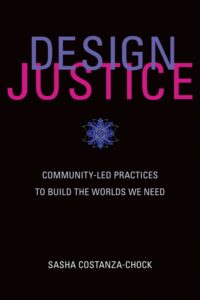[greybox]
A review of
 Design Justice: Community-Led Practices to Build the Worlds We Need
Design Justice: Community-Led Practices to Build the Worlds We Need
by Sasha Costanza-Chock
Publisher: MIT Press
338 pages, 5 chapters
About this book
A good reference for UX Theory
Primary audience: Researchers, designers, and technical roles who are new to the topic
Writing style: Academic, Matter of fact
Text density: Mostly text
Learn more about our book review guidelines
[/greybox]
Design Justice is a must-read for UX professionals who want to understand the connection between design and power. It is an intersectional feminist explanation of how design builds on and reinforces systems of social oppression. Design Justice brings together theoretical academic discussions with anecdotes and examples of how individuals and communities have used design and technology to subvert oppression. Costanza-Chock, a scholar, activist, designer, media maker, and member of the Design Justice Network, shows how assumptions behind standard design practices reinforce social hierarchies. Besides giving the reader a crash course in studies of gender and inequality, the author captivates the reader with unique stories that invite deep reflection. Some examples include how Caribbean communities with access to technology impacted hip-hop, the anarchist roots of Twitter, and #TechWontBuildIt, a movement of tech workers that aims to stop companies from working in projects they deem unethical, like use of facial recognition technology for surveillance. The result is an engaging book that offers UX professionals a more inclusive way of thinking about design as both a practice and an outcome.
To open the book, Costanza-Chock narrates a powerful experience that most people rarely think about: traveling while trans. Most of us go through the Transportation Security Administration’s (TSA) checks at airports with a sense of annoyance about long lines and the inconvenience of taking off our shoes and taking out our laptops. For non-binary and trans individuals (and members of many other vulnerable communities), the process is another instance of ostracism that has real and harmful consequences. Body scanner and TSA patting protocols have most likely been designed by cis-gender individuals. These people made design decisions based on assumptions about sex and gender that exclude trans and non-binary people. In other words, the design of the machines and protocols disproportionately affects those who have the least say in the process and the product. This disproportion is why design justice matters.
Costanza-Chock describes design justice—a term coined by the Design Justice Network—as “…a framework for analysis of how design distributes benefits and burdens between various groups of people. Design Justice focuses explicitly on the ways that design reproduces and/or challenges the matrix of domination…” The author engages with academic literature to explain the need for design justice. What truly drives this home is how Costanza-Chock connects abstract discussions to real stories of how communities have used design to subvert systems of oppression.
Design Justice has highly applicable insights for UX professionals. For example, Constanza-Chock explains how the concept of the unmarked user—generally speaking, a cis, abled-bodied, middle-class man with access to technology—can help us understand who we leave out. It’s striking: When we design for women, people with disabilities, immigrants, people with low literacy levels, gender non-conforming individuals, etc., we usually specify that they are outside the norm. They are marked. The norm is often internalized as men, literate, usually middle-class, able-bodied, etc., which means we don’t explicitly mark these characteristics. These implicit assumptions underlie standard UX practices, the things that UX teams often do as a part of their routine. Without intention, the users who we need to describe end up excluded from the design. In this respect, it is essential to note that design justice acknowledges that, perhaps, no design will be universal. However, the point of design justice is to work towards inclusion by reflecting on who would be disproportionately affected and then actively designing for them.
Costanza-Chock invites her readers to engage the stories we hear and tell about design critically. Power has a strong effect in shaping narratives, and some stories help individuals more than others. Hopefully, one thing that will resonate with UX practitioners is the value of communities. As many readers know, good design is more frequently the work of teams and collaboration; it is rarely the creation of exclusively one person. However, many stories in tech emphasize the value of the individual and the importance of single moments of life-changing inspiration. As the author notes, a single moment of genius makes a great pitch and a fantastic story to tell about a company. To illustrate this example, Costanza-Chock recounts how Twitter was built upon an open-source project that a graduate student created to help coordinate protests in New York. The message is not that the creators didn’t innovate or add value. The point is that, just like with most good UX work, good ideas draw inspiration from somewhere. As UX practitioners, the invitation is to give credit where credit is due.
The book closes with a discussion of the #TechWontBuildIt movement. The movement is an employee-led effort to force large companies to stop building or collaborating with projects that employees think are unethical. In this respect, the author offers an exciting reflection on the role of designers as a part of social movements.
The book is structured in five chapters, with an introduction and a closing section. Each chapter is structured around a value and related critical questions. Chapter 1 analyzes values in design: What values do we encode and reproduce in the systems we design? This is the chapter that discusses, among other things, the unmarked user. Chapter 2 highlights practices: Who gets to design? How do we move toward community control of design processes and practices? Chapter 3 explores narratives: What stories do we tell about how things are designed? How do we scope design challenges and frame design problems? In this chapter, you will learn the connection between activist organization and the roots of Twitter. Chapter 4 deals with sites: Where do we get to design? How do we make design sites accessible to those who will be most impacted by design processes? Chapter 5 talks about pedagogies: How do we teach and learn about design justice? This last section delineates the principles of the Design Justice Network, which are helpful guidelines for UX practitioners interested in inclusion.
Design Justice is full of thought-provoking questions and arguments. While the book is probably best suited for those who have some knowledge of social sciences, it is also a good entry point for those who are interested in design justice and intersectional feminism. The anecdotes and examples make Design Justice approachable for everyone, and it is a great addition to every practitioner interested in inclusion.
[bluebox]
This book is about the relationship between design and power. It’s about the growing community of designers, developers, technologists, scholars, educators, community organizers, and many others who are working to examine and transform design values, practices, narratives, sites, and pedagogies so that they don’t continue to reinforce interlocking systems of structural inequality. It’s about design, social justice, and the dynamics of domination and resistance at personal, community, and institutional levels. In essence, it’s a call for us to heed the growing critiques of the ways that design (of images, objects, software, algorithms, sociotechnical systems, the built environment, and indeed, everything we make) too often contribute to the reproduction of systemic oppression. Most of all, it is an invitation to build a better world, a world where many worlds fit.
[/bluebox]
Maria is a mixed-methods UX Researcher. She holds a Ph.D. in Sociology with concentrations in Demography, Inequality, and Latinx Studies from Cornell University and a MS in User Centered Design from Brandeis University. Twitter: @maluflores

